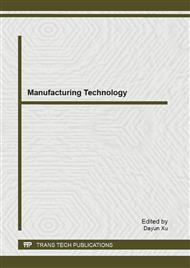[1]
F. C. Wu, R. S. Tseng, R. S. Juang, Adsorption of dyes and humic acid from water using chitosan encapsulated activated carbon, J. Chem. Technol. Biotechnol. 77(2002)1269-1279.
DOI: 10.1002/jctb.705
Google Scholar
[2]
S. Kaneco,K. Itoh,H. Katsumata, Removal of natural organic polyelectrolyte by adsorption onto to bermorite, Environ. Sci. Technol. 37(2003)1448-1451.
DOI: 10.1021/es020816v
Google Scholar
[3]
H. Katsumata, S. Kaneco, R. Matsuno, Removal of organic polyelectrolytes and their metal complexes by adsorption onto xonotlite, Chemosphere. 52(2003)909-915.
DOI: 10.1016/s0045-6535(03)00285-6
Google Scholar
[4]
V.P. Vinod, S. Varghese, T.S. Anirudhan , Adsorption performance of Zr-pillared montmorillonite for the removal of organic pollutants from aqueous phase, Indian J. Chem. Technol. 10(2003)201-210.
Google Scholar
[5]
X. Peng, Z. Luan, H. Zhang, Montmorillonite Cu(II)/Fe(III) oxides magnetic material as adsorbent for removal of humic acid and its thermal regeneration, Chemosphere. 63(2006)300-306.
DOI: 10.1016/j.chemosphere.2005.07.019
Google Scholar
[6]
S. Capasso, S. Salvestrini, E. Coppola, Sorption of humic acid on zeolitic tuff a preliminary investigation, Appl. Clay Sci. 28(2005)159-165.
DOI: 10.1016/j.clay.2004.01.010
Google Scholar
[7]
S. R. Wang, Z. H. Zhu, Humic acid adsorption on fly ash and its derived unburned carbon, J. Colloid Interface Sci. 315(2007)41-46.
DOI: 10.1016/j.jcis.2007.06.034
Google Scholar
[8]
S.K. Kam, J. Gregory, The interaction of humic substances with cationic polyelectrolytes, Water Res. 35(2001)3557-3566.
DOI: 10.1016/s0043-1354(01)00092-6
Google Scholar
[9]
T. Moriguchi, K. Yano, S. Nakagawa, Elucidation of adsorption mechanism of bone-staining agent alizarin red S on hydroxyapatite by FT-IR microspectroscopy, J. Colloid Interface Sci. 260(2003)19-25.
DOI: 10.1016/s0021-9797(02)00157-1
Google Scholar
[10]
J.H. Potgieter, S.S. Potgieter-Vermaak, P.D. Kalibantonga, Heavy metals removal from solution by palygorskite clay, Miner. Eng. 19( 2006)463-470.
DOI: 10.1016/j.mineng.2005.07.004
Google Scholar
[11]
H. Chen, A.Q. Wang, Kinetic and isothermal studies of lead ion adsorption onto palygorskite clay,J. Colloid Interface Sci. 307( 2007)309-316.
DOI: 10.1016/j.jcis.2006.10.054
Google Scholar
[12]
T. Hu, Q.H. Zhang, D. Li, Y.L. Jing, Treatment of fluoride-containing wastewater by attapulgite, Non-Metallic Mines. 29( 2006)52-55.
Google Scholar
[13]
J. J. Bao, G. F. Yu, X. Jiang, W. Peng, Removal mechanisms of phenol from wastewater by modified attapulgite, Environmental Chemistry. 25(2006)37-40.
Google Scholar
[14]
K. Fan, Y. Wang, S. M. Li, Study on removal of organic substances in sewage by modified attapulgite, Journal of Water Resources and Water Engineering. 17(2006)17-20.
Google Scholar
[15]
T.H. Chen, A Discussion on the Adsorption Mechanism of Palygorskite Clay to Pollutants in Wastewater, Geological Journal of China Universitiesf. 6(2000)265-270.
Google Scholar
[16]
D.J. Wu, A Study on Adsorption of Trace Toluene and Butanol Utanol on Clay Attapulgite, Environmental Chemistry. 7(1988)46-49.
Google Scholar
[17]
G. S. Zhang, T.H. Chen, W.Y. Fan, Gas Purification Research of Attapulgite Composite Molecular Sieve , Environmental Engineering. 12(1994)24-28.
Google Scholar
[18]
S.X. Liu, S.X. Jiang, Preparation of Attapulgite Clay Adsorbent and Research on its Decolorizing Property, Environmental Protection of Chemical Industry(1996)377-380.
Google Scholar
[19]
Z.H. Zhu, M.S. Zheng, X.Y. Sun, Cui Ming gao, A Discussion of Attapulgite Decolorizing Adsorbent to Vegetable Oil Decoloration Rate and Chemical Components Role , Non-Metallic Mines(1998)18-20.
Google Scholar
[20]
T.S. Anirudhan, M. Ramachandran, Surfactant-modified bentonite as adsorbent for the removal of humic acid from wastewaters, Applied Clay Science . 35(2007)276–281.
DOI: 10.1016/j.clay.2006.09.009
Google Scholar
[21]
J. Guo, J. Ma, S. Liu, J. Jiang, Adsorption mechanisms of NOM onto the surface of alumina, Acta Scientiae Circumstantiae. 26( 2006)111-117.
Google Scholar
[22]
W. Stumm, Chemical Interaction in Particle Separation, Environ. Sci. Technol. 11( 1977) 1066-1069.
Google Scholar
[23]
Z.Y. Tao, J.Z. Du, Surface Complexation Models at Oxides/water Interfaces, Ion Exchange and Adsorption. 10(1994) 112-118.
Google Scholar
[24]
J.F. Wei, D.Q. Wu, Surface Ionization and Surface Complexation Models at Mineral/water Interface, Advance in Earth Sciences. 15(2000) 90-96.
Google Scholar


